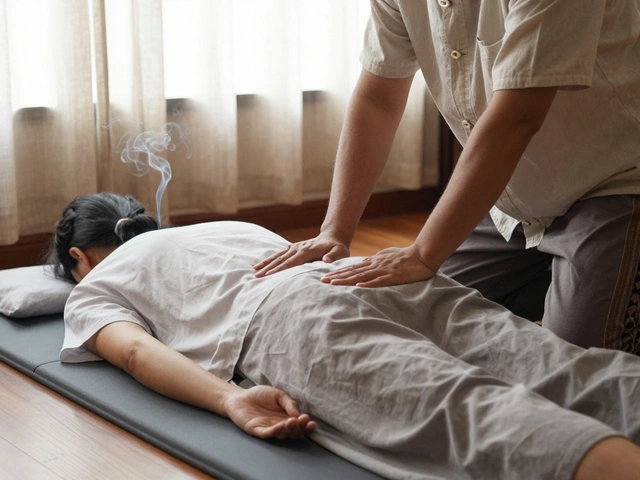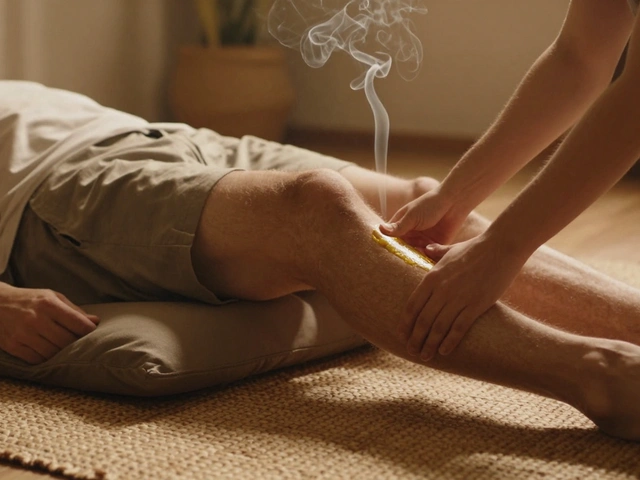Struggling with nagging pain in your back or shoulders? You're not alone. Loads of people turn to body massage every day—not just for pampering, but because it can actually help with real pain. Whether it's a sports injury, tension headaches, or just too much time at a desk, massage has a way of working into those sore spots that nothing else can touch.
But what really happens during a massage for pain relief? If you're picturing fancy resorts and whale sounds, let's set the record straight. These sessions can be as practical as they are relaxing. Therapists use proven techniques—think kneading, pressure points, and targeted stretches—to break up knots, loosen tight muscles, and help your body reset.
Worried about ending up more sore, or just wasting your cash? Smart questions. Picking the right technique and a skilled therapist matters way more than fancy oils or soft lighting. In the sections ahead, you'll get clear advice on the types of massages that really work for pain, how to spot a great provider, and how to prep so you get your money’s worth—and hopefully, some real relief.
- Key Points
- Direct Answer: Does Massage Truly Relieve Pain?
- Types of Body Massage for Pain Relief
- What Happens During a Massage Session
- Tips for Booking and Getting the Best Results
Key Points
Time is precious, so here’s what matters most if you're looking at body massage for pain relief. These highlights will help you cut through the noise and get straight to what works.
- Body massage isn't just about relaxation—it’s proven to help ease back pain, headaches, and even those deep muscle aches you get from sitting too much or overdoing it at the gym.
- There are different types of massages for pain relief—like deep tissue, Swedish, and trigger point—and what works best depends on your specific pain and comfort level.
- You don’t always need a doctor’s note, but it's smart to check with your healthcare provider if you have serious health issues, recent injuries, or ongoing medical treatments.
- Experienced therapists are key. A licensed massage therapist knows how to target areas without making things worse—and will always ask about your pain or discomfort before getting started.
- Massage can be surprisingly affordable—some clinics offer sessions for $60–$120 per hour. Insurance might even help if your doctor recommends it for a medical condition.
| Type of Pain | Massage Type | Typical Relief Reported |
|---|---|---|
| Lower Back Pain | Deep Tissue / Swedish | Up to 50% improvement after 1–3 sessions |
| Neck & Shoulder Tension | Trigger Point / Myofascial Release | Noticeable relief in most after 2 weeks |
| Sports Injuries | Sports Massage | Improved range of motion and less pain |
| Chronic Headaches | Swedish / Trigger Point | Reduces severity and frequency for many |
If you’re pressed for time, these points cover what most people want to know before booking. The right approach can make a big difference, and with a little research, you could feel real results fast.
Direct Answer: Does Massage Truly Relieve Pain?
If you’re hoping massage can actually kick pain to the curb, here’s the straight-up answer: Yes, body massage can really help with pain relief for a lot of people, but it’s not a miracle cure for everyone. There’s some solid science behind it. For example, research in the Journal of Pain showed that people who got massages for back pain felt real improvement after just a few sessions—way better than those who only used meds or did nothing at all.
So, how does it work? Massage boosts blood flow to sore muscles, which helps clear out waste products your body makes when it’s inflamed. It also loosens up tight spots, so you can move easier and ache less. On top of that, your brain gets a boost of feel-good chemicals like endorphins, which are your body’s natural painkillers.
What’s even better is that the right kind of body massage can work for all sorts of pain: headaches, muscle strains, frozen shoulder, and more. In clinics and even hospitals, therapists use massage alongside regular treatments for things like fibromyalgia and arthritis. The key is finding someone who knows their stuff and picking the approach that fits your needs.
Still, massage isn’t magic. If your pain is coming from a broken bone or something super serious, you’ll need a doctor—not just a massage. But for day-to-day soreness, tension, or nagging aches, a good massage can make a real difference and help you get back to your normal.

Types of Body Massage for Pain Relief
Not all massages are created equal, especially when your main goal is pain relief. Picking the right type makes a world of difference. Let’s break down the main options you’re likely to come across—and which ones pack the biggest punch when it comes to actual pain relief.
- Swedish Massage: This is the classic one almost everyone’s tried. It’s all about long, flowing strokes and gentle kneading. Great for relaxing tension, but if you’ve got that deep, stubborn pain, you might want something a little more intense.
- Deep Tissue Massage: Here’s where things get real. Deep tissue uses slow, firm pressure to reach the muscles and connective tissue under the surface. It’s perfect if you’ve got chronic aches, tightness from workouts, or sitting all day. It might feel uncomfortable at times, but that’s how it gets into those problem spots.
- Trigger Point Therapy: Targeting the exact knot or “trigger point,” this one’s about applying direct pressure on those tight muscle areas that send pain elsewhere. Ever get a tension headache from a stiff neck? This is what techs go for to release it.
- Sports Massage: You don’t have to be an athlete to book one. These focus on muscle groups often used in sports, but they’re also perfect for anyone with overuse injuries, strains, or repetitive-motion pain. Expect lots of stretching and specific movement work.
- Myofascial Release: Fascia is the thin, tough tissue covering your muscles. When it’s too tight, things hurt. This massage uses gentle, sustained pressure on the fascia to help everything loosen up. It’s slower but super effective for chronic pain.
If you’re wondering which helps most, a 2023 survey from the American Massage Therapy Association (AMTA) found that deep tissue massage ranked as the top choice for chronic pain, with 82% of clients saying their pain improved after a session.
| Massage Type | Best For | Pressure Level | Duration |
|---|---|---|---|
| Swedish | General tension, stress | Light to medium | 60-90 min |
| Deep Tissue | Chronic pain, tight muscles | Firm | 60-90 min |
| Trigger Point | Specific knots, referred pain | Varies (targeted) | 30-60 min |
| Sports Massage | Injury, overuse, flexibility | Medium to firm | 30-60 min |
| Myofascial Release | Chronic pain, movement issues | Gentle | 60 min |
Here’s what Dr. Tiffany Field, director of the Touch Research Institute at the University of Miami, says about pain relief and massage:
“Massage not only helps reduce pain but can actually improve how your body manages stress, which is a huge factor in ongoing discomfort.”
If you’re not sure where to start, talk to your therapist about what hurts, how long it’s been bothering you, and your daily routine. They’ll match a style to your needs, so you get the most out of that session.
What Happens During a Massage Session
Walking into your first body massage session for pain relief? Here’s exactly how it goes down, minus the mystery. Your therapist will usually start by asking about your pain points, medical history, and what you hope to get out of the session. Don't be shy—this back-and-forth helps target the areas you actually want fixed.
After the quick chat, you'll be shown to a comfortable room and given privacy to undress to your comfort level. Some people go down to underwear, others keep more layers on. There’s always a big sheet or towel for coverage. You won’t ever have to feel exposed.
Once you’re on the massage table, the therapist gets to work. Expect them to start with light pressure to warm things up and check your comfort. Then they’ll move on to firmer pressure, kneading, or using their elbows to work deep tissue knots. It’s totally normal to feel a little soreness where you’re tightest, but you should always speak up if something hurts.
Here’s a quick rundown of what typically happens during a body massage session:
- Initial discussion about your pain, preferences, and past injuries
- Getting undressed to your comfort level and lying on the table
- Therapist uses lotions or oils to reduce friction
- Gentle techniques to warm up muscles, then more focused work on troubled spots
- Possible stretching or movement, especially if you're getting a sports massage
- Checking in with you about pressure and comfort—don’t hesitate to set boundaries
- Closing the session with lighter strokes to help your body wind down
The whole thing usually takes 30 to 90 minutes. If you’re new, start with an hour—it’s enough time to tackle problem zones without feeling rushed.
Wondering how your session might differ based on technique? Here’s a simple table showing what you can expect from common massage types:
| Massage Type | Pressure | Focus Areas | Common Use |
|---|---|---|---|
| Swedish | Light to medium | Whole body | Relaxation, mild pain relief |
| Deep Tissue | Firm | Neck, shoulders, back | Chronic pain, muscle stiffness |
| Sports Massage | Variable (often firm) | Joints and muscles used in your sport/activity | Injury recovery, prevention |
| Trigger Point | Targeted, intense | Very specific tight knots | Sharp, stubborn pain spots |
After the session, you’ll get a few minutes to chill before getting dressed. Drink water to help flush out toxins stirred up in your muscles. Some people feel a little sore as if they’d worked out—that’s totally normal and means your muscles actually released tension. Stick with a trustworthy therapist and don’t be afraid to ask questions. It’s your pain, your session.

Tips for Booking and Getting the Best Results
Nobody wants to waste time or money, so let's break down exactly how to set yourself up for a great body massage experience. Book smart, prep right, and you’ll likely walk out feeling better than you expected.
How to Book Like a Pro
- Check qualifications: Look for licensed or certified massage therapists. This isn’t just a formality; pros know how to handle pain and when to refer you elsewhere if it’s something serious.
- Read reviews, not just ratings: Scan what people say about pain relief and therapist communication. Skip places that sound rushed or inattentive.
- Ask about specializations: Not all massages are the same. Sports, deep tissue, and myofascial release are top picks if pain relief—not just relaxation—is your goal.
- Call ahead: Good therapists get booked out. Don’t just show up and hope for the best, especially for your first session.
- Consider location and timing: Schedule when you’ll have time to rest after your session, especially if it’s your first and you’re unsure how you’ll feel.
How to Get the Most Out of Your Session
- Communicate clearly: Tell your therapist exactly where it hurts, if the pain is new, and how intense it is. Good therapists adjust techniques on the fly.
- Don’t be shy: Speak up if anything feels too intense or not strong enough. You know your body best—your feedback is crucial.
- Drink lots of water afterwards: It actually helps your muscles recover, since massage releases built-up toxins and tension.
- Rest up: Don’t go straight back to hard workouts or strenuous stuff. Give your body time to settle, especially after a deep massage.
No idea what to pay? Prices can range pretty wildly. Here’s an easy cheat sheet:
| Type of Massage | Average Cost (Per Hour) |
|---|---|
| Relaxation/Swedish | $65–$90 |
| Deep Tissue | $75–$110 |
| Sports Therapy | $85–$120 |
| Medical/Clinical | $90–$140 |
One last thing: keep an eye out for package deals if you need more than one session, or see if your insurance covers medical massage with a doctor’s note. Many clinics offer savings for bulk bookings or weekday times. Little tweaks like this can save you a ton without cutting corners on your pain relief.





